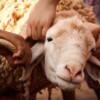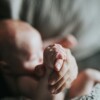In responding to my Art+Faith: A Theology of Making, many have correctly, as Ms. Kresser has done, connected my “slow art” to the pre-industrial mode of creating handmade objects, and to interpret my book as a call to move against the industrial path of utilitarian pragmatism.1 The return to “handmade culture” of the pre-industrial time can be an antidote to such a dehumanizing force of modern times.
In such a call to “slow art,” it may also be tempting to ignore the positive effect of industrialization, and development of modern articulation of technology and medicine, to discard all, even scientific advancement as suspect. Even the traditional Japanese brushes I use are “technology” passed down to me. As a son of a renowned research scientist, Osamu Fujimura, who led the Speech and Hearing Sciences at Bell Labs and other institutions, I am so immersed in the water of scientific progress, as well as the challenges imposed by technology. I may even sound, at times, like a fish complaining about the waves of currents that carries her. Thus, it may be important to emphasize that I am pro-science and technology, was one of the first artists to have a website in the mid-90s, and had an active Twitter feed as early as 2009.
N. T. Wright, in his moving foreword, speaks of Ian McGilchrist’s The Master and His Emissary, in which McGilchrist “explains how Western culture has been increasingly dominated by left-brain rationalism while in fact our brains are designed to work best with the right brain (the “Master”) leading the way and the left-brain (the “Emissary”) working out the details.”2 The most watched YouTube TED Talk called “Do schools kill creativity?,” watched by over 22 million viewers, by the late Sir Ken Robinson also extends McGilchrist’s thesis into education, and urges a new paradigm to begin the journey into what the arts can bring into concerns for the future of education, business, and beyond. If we identify such a blind spot in culture and education, what are we to do about them? How do we develop imagination toward what I deem to be the “New” or “New Newness”?3
Theology of Making calls us to a wider vista toward integration and realignment with these newer currents of digital culture as well. Mere replacement of technology with pre-industrial way of making can fall into unhelpful reductivism. Such reductivism is not what I detect in Ms. Kresser’s comments: but it may be misread by some readers who identify with “slow art” and craft values so much so that they set up a false dichotomy of past versus the present, pre-industrial against post-industrial, Beeple against Willam Morris. Instead, Theology of Making relies heavily on the practice and concept of Kintsugi (Japanese form of “Mending with Gold” the broken tea wares), by accentuating the divide and fractures for the sake of creating something entirely New, and even more valuable than the original. Jesus’s post-resurrection appearances are marked, literally, by his nail marks. And it is through “His wounds that we are healed” (Isa. 53:5). Even in the realm of artificial intelligence and deep learning algorithms, we can find the gold of New Creation, as every domain of our world is under the sovereign territory of what Christ redeemed. In other words, whether art be slow, accelerated, or reversed, God’s New Creation can be imbedded in her.
“How?” is the question asked in Ms. Kresser’s last paragraph:
How can even this hyper-vigilance, this acute sensitivity, be redeployed to heal? If we are all raw nerves, in this age of assaulting plenty, how can we lovingly brandish even these wounds as Christ brandished his?
This “acute sensitivity” comes from a reduced territories of culture that we are forced to operate in, a shrunken ground of scarcity filled, culture-wars land. Such a “hyper-vigilance” environment causes artists to be exiled in the borderlands, exiled from the church and the art world at the same time. Late-modern consumer capitalism (“assaulting plenty”) only values transactional power, wounding the innocent and bullying all to comply to the culture of Darwinian survival. In light of Kintsugi, which Ms. Kresser refers to here, what appears to be severe fracture can be an opening toward healing, with her sharp edges only to be mended, for gold to be applied to be made New.
I suggest such healing paths through Theology of Making; we can reframe the gospel communication to the biblical narrative of Creation-Fall-Redemption-Consummation to Creation-Fall-Redemption-New Creation. While “Consummation” is not a wrong description at all, it assumes the old earth (or what has happened in this side of eternity) to a progressively eschatological fulfillment, which I offer may be misunderstood, in our industrial mindset, as a “fix it” mentality; thus, while a return to hand making may be healing to a post-industrial gnostic curse, it is not in itself exactly a “return to Eden” that we are called to, but participating in the paradigmatic shift of the New toward the City/Garden of God. In this framework, even the flowed mechanism of the past must be redeemed and be made New. But, at the same time, we must believe that the “new Newness” can provide a paradigmatic shift in how we view ourselves and our brokenness, and even reframe how the “flows” have riven through our lives in the first place.
As a survivor of 9/11, living three blocks from where the Towers stood and a decade after, I faced Ground Zero every day and had to ask, “What New can be made upon these Ground Zero ashes?” My art and my life, both broken and redeemed, attest to how we may approach such a quest. Now, all of us are “survivors” of the Pandemic: thus, how we ask that question in our own Ground Zero realities now, and to create into them, will be the “answer” of the deep searing question that Ms. Kresser asks in this thoughtful review. Our art will be far more important, beyond even this illuminating discourse, in opening the door of perception left ajar by the wounded hand of Christ.























